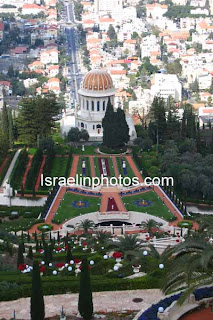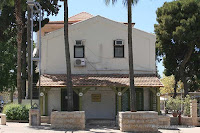Designed by distinguished Canadian Architect William Sutherland Maxwell, the architecture of the Shrine of the Ba'b is a marvellous blend of western and eastern styles.
The granite columns proclaim the glory of classic Roman architecture; the Corinthian capitals are reminiscent of ancient Greece, while the majestic arches bring the flavour of the Orient.
Terraces of the Shrine of the Ba'b
Since 1987 work has been under way to enhance the surroundings of the Shrine of the Ba'b by constructing 18 monumental terraces from the foot to the crest of Mount Carmel, nine above and nine below the Shrine.
Architect Fariburz Sahba, whose design of the Baha'i House of Worship in India commonly known as the Lotus Temple has won international acclaim, has designed these terraces as hanging gardens on the slopes of the Carmel range to create an appropriate setting and approach for this Shrine, one of the most sacred spots for Baha'is.
The Architect explains: The Shrine of the Ba'b is envisaged as a precious gem, for which the terraces provide the setting, like a golden ring for a precious diamond. The terraces are designed as 9 concentric circles, appearing to emanate from the Shrine of the Báb. All their lines and curves direct the eyes and feelings towards that central edifice. The geometry of parallel surfaces and lines have been employed to create the most agreeable and comforting setting for the spectator along the entire landscape.
The natural elements of light and water form the main decoration of the terraces, though a number of beautiful ornaments also adorn the gardens.
The terraces stretch about a kilometre up the mountain reaching a height of 225 metres, and their landscape spans the mountain from 60 metres to almost 400 metres.
One of the distinguishing features of these gardens is the attention paid to conservation of the environment and water resources.
A highly sophisticated state-of-the-art irrigation system has been put in place to conserve water.






































